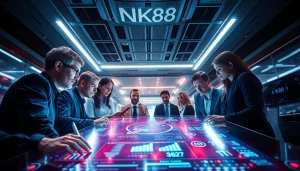Ultimate Guide to Games for Unity: 7 Proven Strategies for Success

Understanding the Basics of Games for Unity
What Are Games for Unity?
Unity is a powerful game development engine that allows creators to design, develop, and deploy games across a variety of platforms, including PC, consoles, and mobile devices. The term “games for unity” encapsulates the diverse range of video games that are built using the Unity engine. From indie games to large-scale productions, Unity provides a flexible and robust framework for game developers. This accessibility has made it one of the most popular engines in the industry, empowering both seasoned developers and novices to bring their creative visions to life.
Core Features of Unity Engine
Unity offers a multitude of features that cater to various aspects of game development. Some of the core features include:
- Cross-Platform Compatibility: Unity enables developers to build their games for multiple platforms with ease, allowing a single codebase to be deployed across desktop, mobile, and console environments.
- Visual Editor: The intuitive drag-and-drop interface allows developers to create game scenes without deep programming knowledge, making the development process more accessible.
- Asset Store: Unity’s Asset Store provides a marketplace where developers can purchase or sell assets such as 3D models, textures, and scripts, streamlining the development process.
- Rich Community and Resources: An extensive community provides forums, tutorials, and documentation, ready to assist developers of all skill levels.
- Strong Support for 2D and 3D Games: Whether you’re developing a 2D platformer or a 3D immersive world, Unity supports both with enhanced features tailored for each.
Why Choose Unity for Game Development?
The decision to choose Unity for game development often stems from its unique advantages. Here are some compelling reasons:
- Ease of Use: Developers can get started quickly thanks to Unity’s user-friendly interface.
- Versatility: Whether you’re developing for VR, AR, or traditional consoles and mobile, Unity can handle it all.
- Strong Community Support: With an active community and extensive documentation, developers can easily find solutions and collaborate.
- Regular Updates: Unity consistently updates its engine to include new features, performance improvements, and bug fixes.
- High-Quality Graphics: Unity supports high-quality graphics, allowing developers to create visually stunning games.
Essentials of Game Design and Development
Key Elements of Game Development
Game development is a multifaceted process that combines creativity and technical skills. Key elements of game development include:
- Game Concept and Storytelling: Every game begins with a compelling concept and storyline that engages players.
- Game Design: This involves creating the rules, structure, and content of the game, including levels, challenges, and character interactions.
- Programming: Utilizing programming languages such as C# within Unity, developers create functionality to bring the game to life.
- Art & Sound Design: Visuals and audio are crucial for immersing players; high-quality graphics and sound effects significantly enhance the gaming experience.
- Testing: Rigorous testing is necessary to identify bugs, ensure functionality, and refine the player’s experience.
Game Mechanics Design for Unity
Game mechanics are the rules and interactions that define gameplay. Designing effective game mechanics involves:
- Understanding Player Motivation: Analyze what motivates players and how they engage with gameplay. This can influence how mechanics are structured.
- Balancing: Create a balance between challenge and reward to keep players engaged without overwhelming them.
- Prototyping: Rapidly prototype game mechanics to test ideas before full implementation, which saves time and resources.
- Feedback Mechanisms: Incorporate mechanisms that provide players with feedback on their actions, enhancing their experience.
Creating Engaging Game Experiences
An engaging game experience is crucial for retaining players. Here are some strategies to enhance engagement:
- Gameplay Loop: Develop a compelling core gameplay loop that keeps players returning, focusing on objectives, actions, and rewards.
- Player Agency: Allow players to make meaningful choices that affect the game world and their experience.
- Aesthetic Consistency: Ensure visual and thematic harmony to create an immersive world that resonates with players.
- Community Engagement: Foster a community around your game through social media, forums, and in-game events to keep players invested.
Tools and Resources for Creating Games for Unity
Essential Plugins and Assets
Incorporating the right tools and resources can significantly enhance game development efficiency in Unity:
- Visual Studio: A powerful IDE to write and debug C# scripts for Unity development.
- Prefab Evolution: This allows developers to create reusable game objects, saving time and effort in game design.
- Fantasy Terrain: For quick terrain generation which enhances the environmental aesthetics of games.
- Post-Processing Stack: Enhances visual fidelity with tools for color grading, anti-aliasing, and more.
Recommended Learning Resources
For those eager to deepen their Unity skills, several learning resources are invaluable:
- Unity Learn: The official learning platform that offers free tutorials tailored to all experience levels.
- YouTube Channels: Channels like Brackeys and Game Dev TV offer extensive content on Unity game development.
- Online Courses: Platforms like Udemy or Coursera feature structured courses on specific aspects of Unity development.
- Documentation: Unity’s comprehensive documentation serves as a reference guide for functionalities used in game projects.
Best Practices for Asset Management
Effective asset management is crucial for maintaining organization and efficiency. Consider the following best practices:
- Folder Structure: Develop a systematic folder structure to categorize assets like scripts, images, animations, and audio.
- Version Control: Implement version control systems like Git to track changes and collaborate efficiently with team members.
- Categorization Tags: Use tags to easily search and filter assets based on specific types or categories.
- Regular Cleanup: Periodically review and delete unused or duplicate assets to keep the project streamlined.
Advanced Techniques in Unity Game Development
Implementing High-Quality Graphics
High-quality graphics can transform a game’s appeal. Techniques to enhance graphics in Unity include:
- Shader Programming: Learning to create and customize shaders can significantly enhance visual effects.
- Lighting Techniques: Utilize dynamic and baked lighting for more realistic environments.
- Level of Detail (LOD): Implement LOD models to optimize performance while maintaining quality based on camera distance.
- Particle Systems: Use Unity’s particle system to create effects like explosions, smoke, and other environmental interactions.
Optimizing Game Performance
Game performance is critical to ensure smooth gameplay. Here are essential optimization techniques:
- Profiling Tools: Utilize Unity’s profiling tools to identify performance bottlenecks and optimize accordingly.
- Memory Management: Use object pooling to reduce the overhead of instantiating and destroying objects frequently.
- Efficient Code Practices: Write clean and efficient code, avoiding unnecessary complexity and redundant processes.
- Graphics Settings: Balance graphics quality to ensure it meets the performance capabilities of your target platforms.
Integrating Multiplayer Functionality
Creating multiplayer experiences introduces additional complexity but can greatly enhance player engagement. Consider the following:
- Networking Solutions: Familiarize yourself with Unity’s UNet or utilize third-party services like Photon for easier implementation of multiplayer features.
- Server Management: Decide between peer-to-peer and dedicated server models, each with its own advantages and challenges.
- Player Synchronization: Ensure smooth synchronization of player actions and game state across different devices.
- Testing Multiplayer Features: Regularly test multiplayer functionalities with real users to identify potential issues and enhance gameplay experience.
Evaluating Your Unity Game Performance
How to Use Analytics in Games for Unity
Analytics play a vital role in understanding player behavior and game performance. Effective analytics strategies entail:
- Integrating Analytics SDKs: Use services like Unity Analytics or Google Analytics to track player interactions and gather insights.
- Key Performance Indicators (KPIs): Identify relevant KPIs such as Daily Active Users (DAU), retention rates, and session lengths to measure engagement.
- A/B Testing: Implement A/B testing to compare game features and understand player preferences while tweaking your game accordingly.
- Data Interpretation: Learn to interpret analytics data to make informed decisions about game development and improvement.
Testing and Iterating on Game Design
Testing is an integral part of game development that ensures quality and player satisfaction. Effective testing strategies should include:
- User Testing: Conduct usability testing with target demographics to identify pain points and areas for improvement.
- Iterative Design: Adopt an iterative approach, using feedback from tests to refine and improve game mechanics continuously.
- A/B Design Comparisons: Trial different game designs or mechanics to determine which resonates more with users.
- Longitudinal Studies: Observe player behavior over extended periods to gauge long-term engagement and satisfaction.
Best Metrics for Measuring Success
Success measurement in game development requires a focus on relevant metrics:
- Retention Rate: Measures the percentage of players returning after their first session, essential for understanding engagement.
- Monetization Metrics: Track Average Revenue Per User (ARPU) and Lifetime Value (LTV) for insight into revenue generation.
- Engagement Metrics: Analyze session durations and frequency to evaluate how engaging your game is over time.
- Cohort Analysis: Monitor the behavior of groups of users over time to understand which features improve retention and satisfaction.







